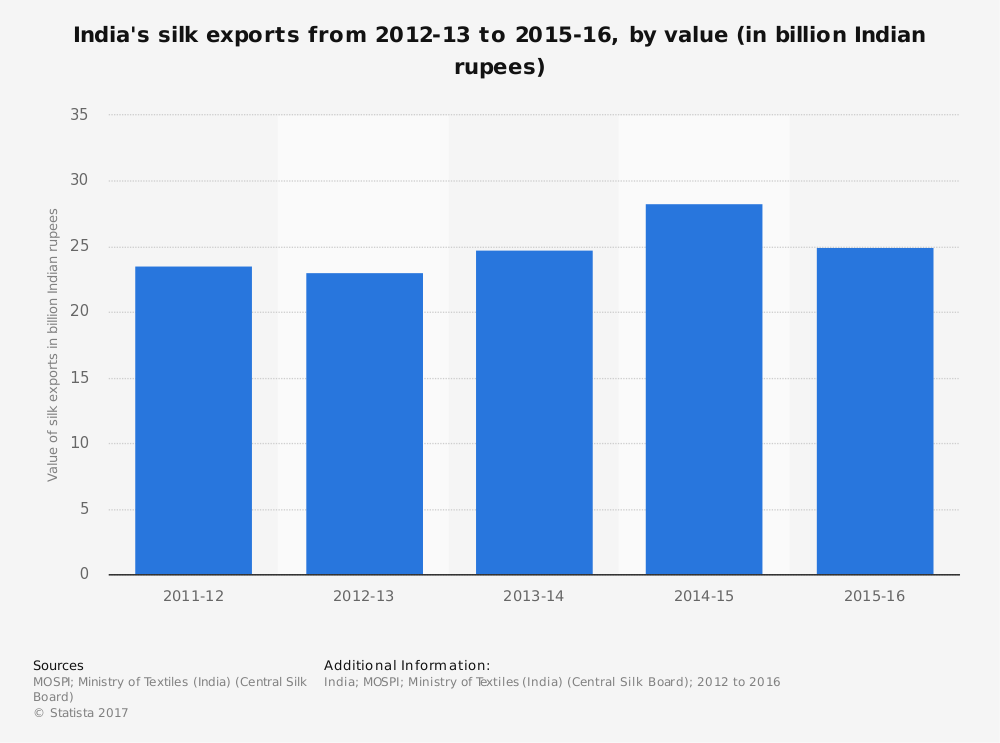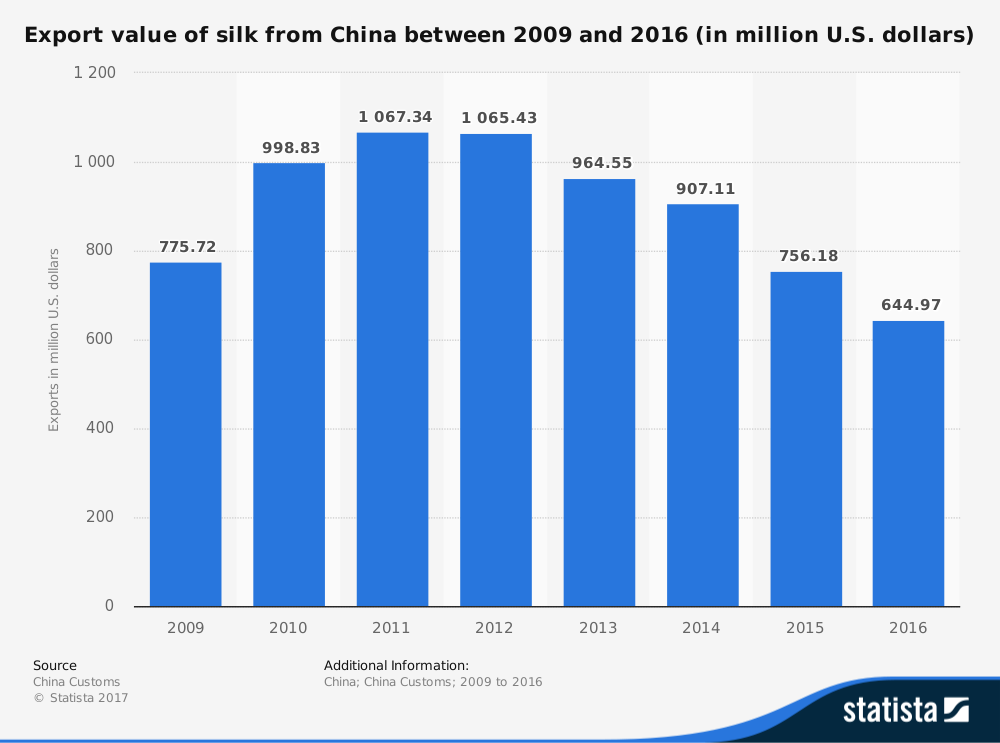The silkworm industry is one of the oldest in the world. It may have started as early as the 50th century BC in China. It came to India in the 2nd century AD. The Silk Road was based on the idea that silk products could spread to the rest of the world. China and India continue to lead the industry, but countries like Uzbekistan, Brazil, Thailand, and Vietnam contribute to the global industry as well.
To obtain silk, it must be harvested from silkworms. When the larvae form a cocoon, the industry then boils the product, which kills the pupae silkworm. Then the cocoons are unwound on a reel. It requires about 2,500 silkworms to produce 1 pound of raw silk.
Interesting Silkworm Industry Statistics
#1. The current production of silk on a global scale is estimated to be about 200,000 metric tons. China and India currently have 90% of the total silk market, but China holds an 80% share all on its own. (Texere Silk)
#2. Brazil is the only country outside of Asia that is listed as a major contributor to the silkworm industry, producing raw silk and silk yarn. (Texere Silk)

#3. The United States is the largest importer of silk products in the world today. (Texere Silk)
#4. Silk production is an automated process today, but silkworm product is still a practice that is done using traditional practices. Many silkworm-raising facilities are based out of people’s homes. In some instances, the local government may subsidize families who want to get involved with the industry. (Facts and Details)
#5. About 1 million people are employed within the silk sector in China. Another 7.9 million people are employed in India, while Thailand employs about 20,000 families that weave silk. (International Sericultural Commission)
#6. Silk has a very small part of the global textile market. Recent estimates place it at just 0.2% of the total market. Precise values are difficult to collect as most importing countries do not track data on what is imported each year. (International Sericultural Commission)
#7. In 2016, China produced an estimated 158,400 metric tons of silk. India produced about 30,000 metric tons. Only Uzbekistan produces more than 1,000 metric tons per year otherwise, which places them third in overall global production. (International Sericultural Commission)
#8. Silkworms eat a diet that is 100% mulberry leaves. In 2016, the total area of mulberry fields in China was reduced by 3.4%. Seed volumes were reduced by 1.8%. That meant the silk cocoon yield was reduced by 1.2%. (International Silk Union)
#9. Although total harvests of silk were down in 2016, the mean acquisition price for the industry rose by nearly 13%. (International Silk Union)
#10. Guangxi Province continues to lead the world in total silkworm cocoon production. It produced a total yield in 2016 of 299,5000 tons, which was a 4.5% increase over the year before. Harvests from this province account for 48% of the total silkworm yield that China sees every year. (International Silk Union)

#11. India has become the largest importer of raw silk to meet local demand, despite the fact that it is the world’s second-largest producer of finished silk products. (International Trade Forum)
#12. Italy is usually the top importer of silkworm products in Europe. In 1997, the last year of accessible data, more than 3,200 tons of raw silk was imported to Italy. Another 700 tons of silk yarn was imported, along with 300 tons of garments. (International Trade Forum)
#13. More than 70% of the silk fabrics that have been imported to the French market from China and India have gone toward clothing creation. (International Trade Forum)
#14. 10% of the silk market in the United States is dedicated to home furnishings. Top products that contain silk for the U.S. market include thermal underwear, casual clothing, and products with easy-care properties. (International Trade Forum)
#15. From the 1970s to today, Japan has seen their silk production drop from 20,000 tons per year to under 1,000 tons per year. About 90% of the silk products which are available in Japan are in the form of kimonos. (International Trade Forum)
#16. More than 2,200 silkworm enterprises are currently active in China right now. Hangzhou is one of the largest manufacturers of silk products, with 600 active facilities that produce everything from fabric to clothing to raw materials for export. (Fiber to Fashion)
#17. In 2006, the silk industrial output value for the silkworm industry in China reached more than $30 billion for the first time. In 2010, silk exports to the United States from China reached $5 billion for the first time. (Fiber to Fashion)
#18. There are about 35 different types of silk that are available through the silkworm industry. These different types are categorized into three main grades, designated as Category A, Category B, and Category C. Category A silk can be unraveled with the floss breaking from the action, which means it could stretch out for as much as a mile. (Mariann Silk)
#19. Silkworms typically live about 28 days. They live on trays or baskets that are filled with mulberry leaves. The trays and baskets remain open since silkworms prefer to eat more than anything else. The average silkworm can increase its body weight by 10,000 times in just 1 month. (Facts and Details)
#20. 100kg of mulberry leaves will typically yield about 25 silkworm cocoons. For the average Japanese kimono, over 100 pounds of mulberry leaves were consumed. (Facts and Details)

#21. A supply of 8,000 silkworms can produce enough product to create about 10 blouses. That equates to a consumption of over 350 pounds of mulberry leaves. (Facts and Details)
#22. The quality of the silk produced is dependent upon the care of the silkworms. With more food and consistent temperatures, higher grades of silk are possible. Those who raise silkworms in China are often forbidden to smoke, cannot eat foods with garlic, have clean sandals, and are not allowed to wear make-up. (Facts and Details)
Silkworm Industry Trends and Analysis
The silkworm industry has been part of human cultures since the very beginning of the modern era. Silk once helped to establish trade routes and create more openness in the world. Today, this industry helps to provide employment for millions of people, indirect employment for millions more, and is a thriving multi-billion-dollar industry despite its relatively low market share in the global textile market.
Because the traditions of silk are so established, this industry will continue to succeed. Local demand often outweighs available supply, which drives pricing upward. It also creates shortages for the export market, which further drives prices upwards.
Although millions of people visit Brandon's blog each month, his path to success was not easy. Go here to read his incredible story, "From Disabled and $500k in Debt to a Pro Blogger with 5 Million Monthly Visitors." If you want to send Brandon a quick message, then visit his contact page here. Brandon is currently the CEO of Aided.
